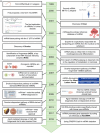MicroRNA Gets a Mighty Award
- PMID: 39836690
- PMCID: PMC11831481
- DOI: 10.1002/advs.202414625
MicroRNA Gets a Mighty Award
Abstract
Recent advancements in microRNAs (miRNAs) research have revealed their key roles in both normal physiological processes and pathological conditions, leading to potential applications in diagnostics and therapeutics. However, the path forward is fraught with several scientific and technical challenges. This review article briefly explores the milestones of the discovery, biogenesis, functions, and application for clinical diagnostic and therapeutic strategies of miRNAs. The potential challenges and future directions are also discussed to fully harness their capabilities.
Keywords: RNA biology; biomarker; cancer; miRNA; therapeutic approach.
© 2025 The Author(s). Advanced Science published by Wiley‐VCH GmbH.
Conflict of interest statement
The authors declare no conflict of interest.
Figures




Similar articles
-
miRNA and cancer; computational and experimental approaches.Curr Pharm Biotechnol. 2014;15(5):429. doi: 10.2174/138920101505140828161335. Curr Pharm Biotechnol. 2014. PMID: 25189575
-
Trials and Tribulations of MicroRNA Therapeutics.Int J Mol Sci. 2024 Jan 25;25(3):1469. doi: 10.3390/ijms25031469. Int J Mol Sci. 2024. PMID: 38338746 Free PMC article. Review.
-
MicroRNA and cancer--a brief overview.Adv Biol Regul. 2015 Jan;57:1-9. doi: 10.1016/j.jbior.2014.09.013. Epub 2014 Sep 28. Adv Biol Regul. 2015. PMID: 25294678 Review.
-
Functional characterization of a 'plant-like' HYL1 homolog in the cnidarian Nematostella vectensis indicates a conserved involvement in microRNA biogenesis.Elife. 2022 Mar 15;11:e69464. doi: 10.7554/eLife.69464. Elife. 2022. PMID: 35289745 Free PMC article.
-
MicroRNA in cancer therapy: breakthroughs and challenges in early clinical applications.J Exp Clin Cancer Res. 2025 Apr 21;44(1):126. doi: 10.1186/s13046-025-03391-x. J Exp Clin Cancer Res. 2025. PMID: 40259326 Free PMC article. Review.
Cited by
-
Research progress on non-coding RNA regulatory networks and targeted therapy in diabetic nephropathy.Front Endocrinol (Lausanne). 2025 Jul 29;16:1625307. doi: 10.3389/fendo.2025.1625307. eCollection 2025. Front Endocrinol (Lausanne). 2025. PMID: 40801037 Free PMC article. Review.
-
Hybridization Chain Reaction-Enhanced Ultrasensitive Electrochemical Analysis of miRNAs with a Silver Nano-Reporter on a Gold Nanostructured Electrode Array.J Funct Biomater. 2025 Mar 12;16(3):98. doi: 10.3390/jfb16030098. J Funct Biomater. 2025. PMID: 40137377 Free PMC article.
-
Recent advances in early diagnosis and treatment of T1D with miRNAs.Front Endocrinol (Lausanne). 2025 May 15;16:1582963. doi: 10.3389/fendo.2025.1582963. eCollection 2025. Front Endocrinol (Lausanne). 2025. PMID: 40444240 Free PMC article. Review.
-
Interplay of miR-243 and microbial interactions in aging and transgenerational immunity.Gut Microbes. 2025 Dec;17(1):2537750. doi: 10.1080/19490976.2025.2537750. Epub 2025 Jul 28. Gut Microbes. 2025. PMID: 40717567 Free PMC article.
References
-
- Reinhart B. J., Slack F. J., Basson M., Pasquinelli A. E., Bettinger J. C., Rougvie A. E., Horvitz H. R., Ruvkun G., Nature 2000, 403, 901. - PubMed
-
- a) Peng W., He Z., Dai W., Lan W., Briefings in bioinformatics 2023, 25, bbad524; - PMC - PubMed
- b) Calin G. A., Dumitru C. D., Shimizu M., Bichi R., Zupo S., Noch E., Aldler H., Rattan S., Keating M., Rai K., Rassenti L., Kipps T., Negrini M., Bullrich F., Croce C. M., Proc. Natl. Acad. Sci. USA 2002, 99, 15524; - PMC - PubMed
- c) Lee Y., Ahn C., Han J., Choi H., Kim J., Yim J., Lee J., Provost P., Radmark O., Kim S., Kim V. N., Nature 2003, 425, 415. - PubMed
-
- The Nobel Prize in Physiology or Medicine, https://www.nobelprize.org/prizes/medicine/2024/summary/, (accessed: October 2024).
-
- Lagos‐Quintana M., Rauhut R., Lendeckel W., Tuschl T., Science (New York, N.Y.) 2001, 294, 853. - PubMed
Publication types
MeSH terms
Substances
Grants and funding
- JCYJ20220530114415036/Shenzhen Municipal Science and Technology Innovation Commission Foundation in China
- JCYJ20210324104800001 to G.C/Shenzhen Municipal Science and Technology Innovation Commission Foundation in China
- JCYJ20220818100412028 to H.R/Shenzhen Municipal Science and Technology Innovation Commission Foundation in China
- 32070625 to G.C. 82170159 to H.R/National Natural Science Foundation of China
- 2021YFA0909300/National Key Research and Development Program
LinkOut - more resources
Full Text Sources
